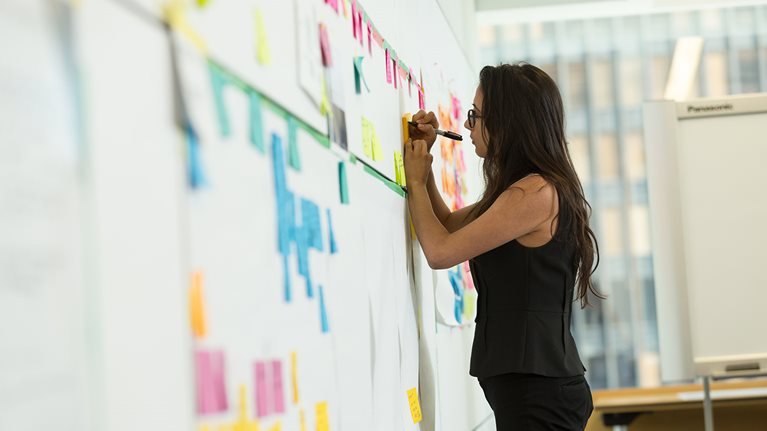Last month, 50-plus senior executives and McKinsey partners from consumer goods, healthcare, banking, and more gathered in our New York Experience Studio for our 15th Organizational Agility Forum. Since starting just two years ago, this two-day workshop has helped over 200 senior leaders across all industries and 20 countries develop practical plans to help their own organizations become more flexible and highly functioning amid the constant market disruptions today.
One team at the forum, from a global investment-management firm, had already piloted agile processes across 3,000 of its employees and now wanted guidance on next steps: how to scale up across the enterprise and to adapt its infrastructure. Another team from an automotive company was just starting out, using the workshop to define a future agile organizational model that it could take back to its board.
McKinsey experts help executives envision what enterprise agility actually looks like for their companies and start a plan. “This can be anything from a roadmap on how to create small, autonomous teams to drafting their ‘change story’ for an employee’s town hall,” says Steven Aronowitz, a partner in the Organization Practice.

“We then get very tactical, walking through specific journeys of companies that have become agile—what they did—and continue to do—to sustain that,” adds Steven.
The ability to adapt boils down to organizational design, an area McKinsey has been immersed in for decades, and, increasingly, their level of enterprise agility. “To keep up, many companies are reorganizing more frequently—every two years, on average—and those that do it well are thriving,” says Wouter Aghina, a partner in our Organization Practice.
“Agile is about looking holistically across the people, processes, structure, strategy, and technology and stripping away the bureaucracy and layers of hierarchy to move more quickly,” says Allan Jaenicke, an expert associate principal. “Empowering people to make decisions regardless of title or rank and using technology as a way to share ideas is what works more effectively.”
“Ultimately, it’s about achieving this paradox of stability and dynamism,” said Michael Lurie, a senior expert in agile transformations, during one of the forum exercises. Looks of puzzlement filled the room. “That feels counterintuitive to me,” said one client from a pharma company while others nodded in agreement. How can you be both nimble and fast moving—like, say, a start-up—in a bureaucratic organization?
That’s a good question. As an analogy, Michael used Steve Jobs’s consistent outfit: a black turtleneck and blue jeans. Jobs, Michael explained, “didn’t have to devote any headspace to what were extraneous tasks to him—like his clothing. Instead, he could pool all his energy into creating world-changing technology.” For companies today, this means deciding which aspects of work can be kept stable, such as a shared vision and purpose, to free up space for dynamism in other areas.
“It’s hard to know which areas to focus on at first,” says Monica Murarka, a senior knowledge manager. “Most organizations start transforming by doing pilots with their customer-facing units—innovation, customer experience, sales and servicing, and product management—but just as important is having a performance-based culture void of judgment and fear of failure.” She adds, “Without this, it’s very difficult to scale beyond pilots.”
Ideas about enterprise agility extend beyond the teachings of these workshops. “We’re continuously reinventing the forum itself, based on feedback and by applying insights from our own client work,” says Wouter. The forums—invitation-only events for senior executives—are held around the world throughout the year. To learn more about it, get in touch with us here.